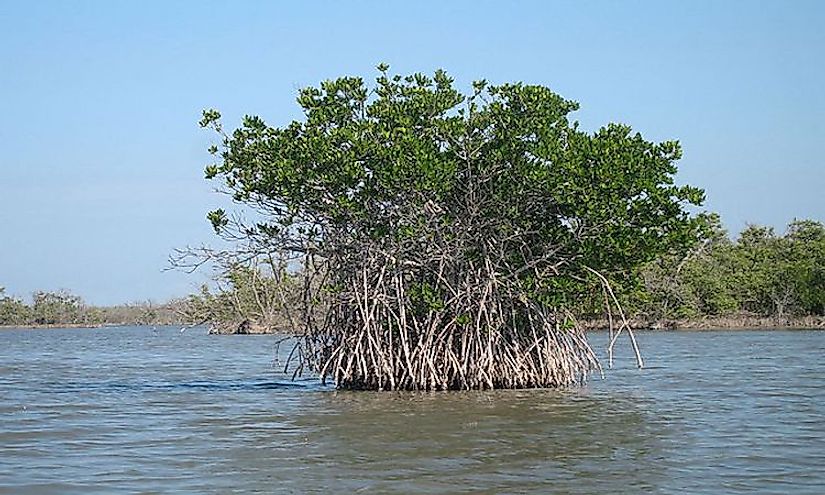Ecological Regions Of Gabon

Gabon is located on the equator on the west coast of central Africa. Libreville is the capital as well as the largest city in the country, and French is the official language. There are several ethnic groups in the country including; Fang (28.6%), Punu (10.2%), Nzebi (8.9%), French (6.7%) and Mpongwe (4.1%). Gabon is widely known for its efforts in conservation of the environment with over 10% of the country being covered by national parks and having one of the largest proportions of the nature parkland in the world. The country experiences equatorial climate with year round high temperatures and humidity. In this article, we will discuss various ecological regions found in Gabon.
Ecological Regions Of Gabon
Atlantic Equatorial Coastal Forests
The Atlantic Equatorial, Coastal Forests region covers an area of 73,200 square miles and extends along the Atlantic coast. Apart from Gabon, other countries covered by the ecoregion include; Cameroon, Equatorial Guinea, Republic of Congo, and the Democratic Republic of Congo. It is a forested region which is home to mammal which includes; Chimpanzees, Western Gorilla, forest elephants, and buffaloes. It is also rich in smaller mammals, amphibians, birds, and reptiles. The area also has a very high level of endemism and currently is home to over 50% of endemic plant life of West Africa. Endemic animals in the region include; the sun-tailed monkey, the long-footed shrew, and the African smoky mouse.
Central African Mangroves
The Central African mangroves region is characterized by mangroves growing on the fertile river mouths and lagoons. They contain tall trees measuring up to 150 feet in height. Mangroves thrive in humid tropical climates where the sea is warm, and therefore they have thrived at the mouth of the Muni River. The region has five main species of mangrove which are, the red mangrove, the black mangrove, the white mangrove, the Rhizophora racemosa and, the Rhizophora harrisonnii. A palm species, Nypa fruticans, was introduced from Asia. Apart from being the source of tributaries and creating build-ups of nutrient rich soils on the river banks, the mangroves are home to a vast collection of wildlife. There are a large number of oysters, crabs, fish and other invertebrates sheltering ad spawning in the ecoregion. There are also some primates and turtles found in the mangroves. There are birds which are permanent inhabitants in the region while others just stay for some time during the migration period.
The Gulf Of Guinea Central
The Gulf of Guinea Central ecoregion largely contains mangroves of the Niger Delta. They are the single most extensive mangrove system in Africa and third globally after India and Indonesia. The mangroves are essential in stabilizing the shoreline. They also act as the nursery areas for fish and shrimps. The dominant species of mangroves is the Rhizophora racemose. The area has a diverse collection of animals including; manatee, crocodiles, clawless otter, squirrels, African Fish-eagle, and the African skimmer. Population pressure has threatened the existence of this ecoregion. Some of the threats attributed to population pressure include; urbanization, industrialization, timber and petroleum exploitation, dynamite and poison fishing, discharge of sewerage, and sand mining. Oil spills and development projects have led to the death of invertebrates and fishes.
Northwestern Congolian Lowland Forests
The Northwestern Congolian Lowland Forests is part of the Congo Basin rainforest and is one of the richest areas globally for primates. Some of the big mammals include the forest elephant, buffaloes, chimpanzees, and gorillas. Butterflies, amphibians, and birds are also found in large numbers in the area. There are more than 6,000 vascular plant species in the area. This area experiences a tropical climate with high rainfall and temperatures all the year round. The forests are hard to be penetrated by human beings and have therefore remained largely intact.
Environmental Threats To Conservation
Logging has been cited as the leading threat to the Atlantic Equatorial Coastal Forests ecoregion. Other threats are hunting of primates for meat. Elephants are also excessively hunted for meat and ivory. the Central Africa Mangrove is facing a problem with Clearance of the mangroves for industrial use mangroves are resilient and can withstand the change in climate.
Ecological Regions Of Gabon
| Ecological Regions Of Gabon | Biome |
| Atlantic Equatorial coastal forests | Tropical and Subtropical Moist Broadleaf Forests |
| Central African mangroves | Mangroves |
| Central West Coastal Equatorial | West Coastal Equatorial Freshwater |
| Gulf of Guinea Central | Marine |
| Northwestern Congolian lowland forests | Tropical and Subtropical Moist Broadleaf Forests |
| Southern West Coastal Equatorial | West Coastal Equatorial Freshwater |
| Western Congolian forest-savanna mosaic | Tropical and Subtropical Grasslands, Savannas, and Shrublands |







